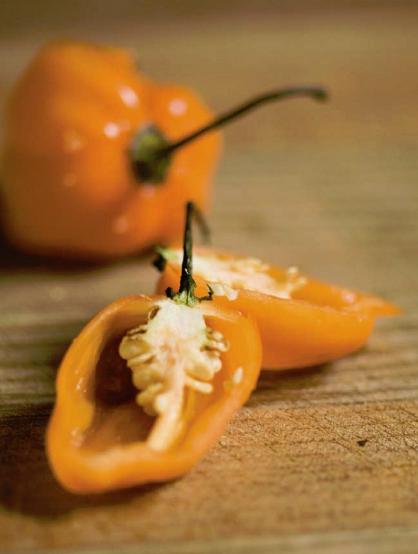
okra pickles
Many southerners have been the butt of jokes because they eat the slimy stuff called okra. First brought to this country by slaves from Africa, okra has remained a popular, and even cherished, vegetable. The pods require a goodly dose of acidification to safely pickle. Still, the end result is something to behold. Pickled okra is not the slimy thing the steamed version becomes. They are firm, with a fine pickled flavor, go well in salads and are sought after as a party finger food. Pickled okra often arrives with the tailgate crowd at southern college football games. One will see “them good ol’ boys” with a beer in one hand and a pickled okra pod in the other.
CANING NOTES
• This is a water bath, acidified recipe.
• pH of okra is high. Final pH will be around 4.1.
• The solution will fill 6 pint jars. Half pints will work, but only with small pods.
• One can produce as many jars as is practical.
• Each pint jar will require approximately 3/4 pound of fresh okra.
IN EACH JAR
3/4 pound okra, washed and prepared
2 cloves garlic
1 teaspoon mustard seeds
1 or 2 hot peppers (preferably red, like chili peppers)
BOiling Solution 4 cups white vinegar
4 cups white vinegar (5 percent acidity)
2 cups water
6 tablespoons salt
Wash okra and trim any excess stems.
Put garlic and mustard seeds in jars and then fill the bottom with okra pointing up. Next, place a second layer of okra pointing down above and between the first layer. Be certain not to have okra ends sticking above the canning line on the jar.
Put peppers in last, pressed against the side of the jar half way down.
Place jars in canning rack and fill with boiling solution.
Conduct initial pH test of liquid in center jar. If above 4.2, either incorrect acidity vinegar was used or mixture of vinegar and water was improperly measured. Discard liquid and begin again.
Water bath to 185 degrees F according to the safe canning practices outlined .
Perform final pH testing after 24 hours by macerating an okra pod in 1 cup of distilled water to insure safe canning was accomplished and the pH is below 4.5.
NOTE: Okra is hollow and will absorb the majority of the canning liquid. This is fine, and I think looks better, although federal inspectors used to have a hissy fit with me when I did mine like this. They preferred that I keep topping off the liquid in the water bath jars as they heated. This is not necessary.
